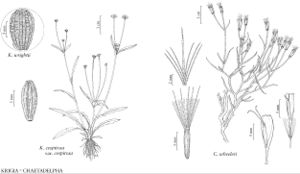Krigia
Gen. Pl. 2: 532. 1791.
| Taxon | Illustrator ⠉ | |
|---|---|---|
 | Krigia wrightii Krigia cespitosa var. cespitosa Chaetadelpha wheeleri | Yevonn Wilson-Ramsey Yevonn Wilson-Ramsey Bee F. Gunn |
Annuals or perennials, 3–75 cm; taprooted, fibrous-rooted, or (in K. dandelion) with rhizomes bearing globose tubers. Stems 1–50+, usually erect, rarely decumbent, scapiform or branched distally, glabrous or sparingly villous (proximally), glandular-villous (especially distally). Leaves mostly basal, sometimes cauline; petiolate (petioles often winged); blades linear to lanceolate, oblanceolate, or spatulate, margins entire, denticulate, or irregularly pinnately lobed, apices acute to obtuse (faces glabrous or glandular-villous, usually glaucous in K. dandelion and K. biflora); distal cauline usually slightly reduced to bractlike. Heads borne singly. Peduncles not distally inflated, ebracteate (from rosettes and from axils of cauline leaves or bracts). Calyculi 0. Involucres turbinate to campanulate, 2–12 mm diam. Phyllaries (4–) 5–18 in 1–2 series, (sometimes reflexed in fruit) linear-lanceolate to ovate, equal, herbaceous, apices acute (faces glabrous). Receptacles flat or low-convex, pitted, glabrous, epaleate. Florets 5–60; corollas yellow to orange (equaling or surpassing phyllaries). Cypselae brown or reddish-brown, columnar, obconic, barrel-shaped, or fusiform, not beaked, nerves or ribs 10–20, glabrous; pappi 0, or persistent, often fragile, usually in 2 series, distinct, outer of 5+, yellowish or brownish scales, inner of 5–45, barbellulate bristles (pappi 0 in K. cespitosa, 0 or 1 series of tiny scales in K. wrightii). x = (4) 5 (6, 9).
Distribution
North America, ne Mexico
Discussion
Species 7 (7 in the flora).
Krigia is diverse and limited to North America. On molecular evidence, it stands apart from other clades of Cichorieae and is best placed as a monotypic subtribe (J. Lee et al. 2003; Lee and B. G. Baldwin 2004). Early studies classified the pappose and epappose species as different genera. A unified view of the genus was taken by L. H. Shinners (1947), and this has been supported by recent morphologic and molecular studies (K. J. Kim and T. J. Mabry 1991; Kim and B. L. Turner 1992; Kim et al. 1992b, 1992c; Kim and R. K. Jansen 1994). The most common base number is x = 5, with lower and higher numbers having arisen through dysploidy, autoploidy, and both ancient and recent alloploidy (K. L. Chambers 1965, 2004; A. S. Tomb et al. 1978; C. C. Chinnappa 1981; Kim and Turner).
Selected References
Lower Taxa
Key
| 1 | Perennials; involucres 7–15 mm; phyllaries reflexed in fruit; pappus bristles 14–45 | > 2 |
| 1 | Annuals; involucres 2–9 mm; phyllaries usually erect in fruit (reflexed in K. virginica); pappus bristles (1–)4–5, or pappi 0 | > 4 |
| 2 | Stems scapiform, never leafy or bracteate; peduncles from basal rosettes (1–5+ per plant); tubers (on rhizomes) globose | Krigia dandelion |
| 2 | Stems leafy or bracteate; peduncles from axils of cauline leaves and bracts (first-formed peduncle sometimes arising basally in K. montana); tubers none | > 3 |
| 3 | Peduncles usually in groups of 2–6 from axils of distal cauline, auriculate, clasping bracts (on scapiform stems arising from basal rosettes); corollas orange or yellow- orange (leaves usually glaucous) | Krigia biflora |
| 3 | Peduncles usually arising on leafy branches axillary to well-developed cauline leaves; corollas yellow | Krigia montana |
| 4 | Phyllaries reflexed in fruit; pappus bristles surpassing scales by 3+ mm | Krigia virginica |
| 4 | Phyllaries erect in fruit; pappus bristles 0 or surpassing scales by no more than 2 mm | > 5 |
| 5 | Phyllary midveins evident, not prominent nor forming curved keels; cypselae fusiform, broadest beyond middles (gradually tapering distally), apical areas ± equal to basal areoles; pappi 0 | Krigia cespitosa |
| 5 | Phyllary midveins becoming prominent, curving inward at bases to form keels; cypselae obconic to broadly columnar or barrel-shaped, broadest at or just proximal to apices, apical areas broader than basal areoles; pappi 0, or of scales and bristles. | > 6 |
| 6 | Peduncles from rosettes; cypselae broadly obconic; pappi usually of 5 scales 0.4–0.6 mm plus 5 bristles 1.2–2 mm | Krigia occidentalis |
| 6 | Peduncles mostly from branching, leafy stems; cypselae broadly columnar or barrel-shaped, slightly constricted at apices; pappi 0, or coroniform (minutes scales, rarely with 1–5 bristles). | Krigia wrightii |
"fine" is not a number.